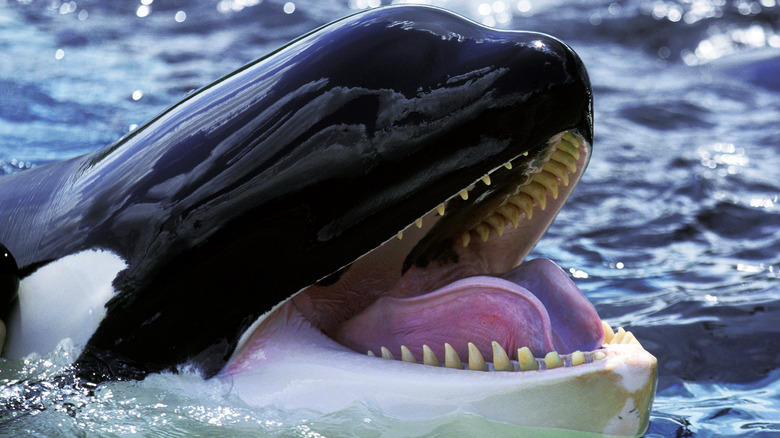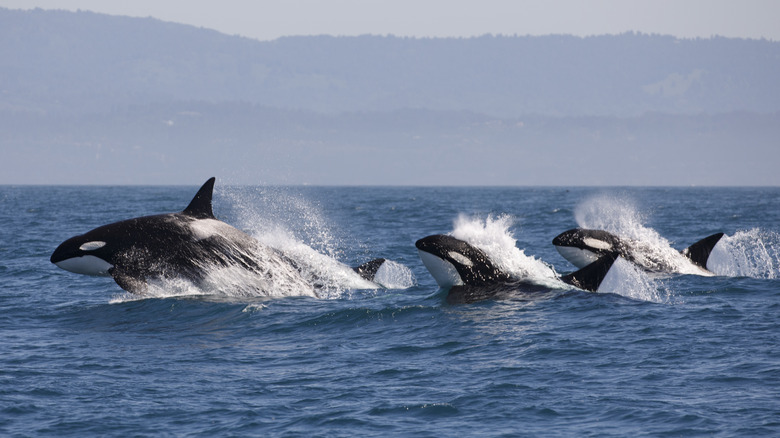The Possible Reason Orcas Are Attacking Sailboats
Everyone has been posting their nostalgic "Teenage Dirtbag" moments on social media for all to see, but those captured cringe moments aren't just for human teens (and no, we're not talking about Mutant Ninja Turtles, either). A surge of videos online have been surfacing (including this posting on YouTube), showing teen orca whales, otherwise harshly know as killer whales, attacking sailboats for no apparent reason whatsoever (via NPR). It has been mainly happening off the European coast, and although scientists have several theories as to why the orcas are doing it, no one truly knows why.
We all know teenagers can be a bunch of rascals, vandalizing or trespassing on private property, drinking and throwing ragers while their parents are out of town. We also know that the flames of mischief are only fanned when peer pressure comes into the mix. And according to scientists, that may very well be the explanation behind the rowdy orca behavior (via Live Science).
Expensive sneakers, or a dead salmon hat?
Human teens may feel obliged to wear an over-priced shoe or jacket that everyone at school is wearing, or maybe go to a place their parents told them not to because "all the cool kids are doing it." To which the supervising adult often replies, "would you jump off the Brooklyn Bridge if everyone was doing it?" In the case of this story, would human teens wear a dead salmon carcass on their head if everyone was doing it? No, probably not, but orca youngsters would (via Live Science).
Orcas are incredibly social creatures. They're technically dolphins, not whales, and just like other dolphins, orcas have previously been known to follow fads. Back in 1987, a group of teen orcas off the coast of Washington began wearing dead salmon on their heads, like hats, because one female orca (no doubt the orca Prom Queen) began doing it. However, after six weeks, the whole group stopped doing it. The following summer, some orcas tried to bring it back, but were quickly reminded by their peers that behavior was "so last season," and the trend died out completely. This previously observed behavior lead scientists to believe the recent ramming of boats by pods of teen orcas is a similar fad. One of the most recent attacks, however, made scientists doubt this theory. Fads among human adolescents often spread like wildfire internationally thanks to TikTok, but whales don't have TikTok. Usually, their fads stay in one region — which is not the case here.
It's not just a phase, Mom!
One of the most recent incidents took place in August, while Ester Kristine Storkson and her father were sleeping on their small yacht (via NPR). The father-daughter-duo were on an adventurous expedition to sail around the entire globe when they were shaken awake. Storkson came on deck in a panic and found several orcas ramming the 37-foot sail boat — one time so hard that the boat spun 180 degrees. After the hooligans tired themselves out and left, the Storksons investigated and found three-quarters of the boat's rudder had been broken off, and other metal components were bent. Luckily, they were able to make it to the French coast for repairs.
This damage is in line with the other incidents, but the location is off, leading scientists to believe other theories. Most of the other incidents have happened near Spain and Portugal, and not as far north as France (via Live Science). It is also very unlikely the same pod of orcas would have made a day-trip to France, just to cause some mischief. Scientists say it is likely orca whales like the feeling of water pressure from boat rudders on their faces, and get frustrated when it is turned off. However, at least one incident occurred when the boat's rudder was moving, leading scientists to believe these social, teen whales may just be curious about moving boat parts. Regardless of their reasoning, we can only hope these rambunctious youngsters will grow out of this phase, and leave human sailors alone.


